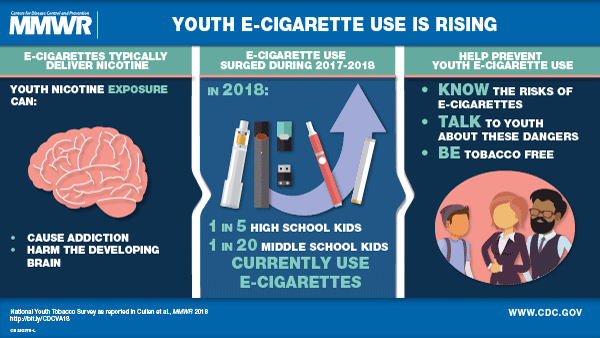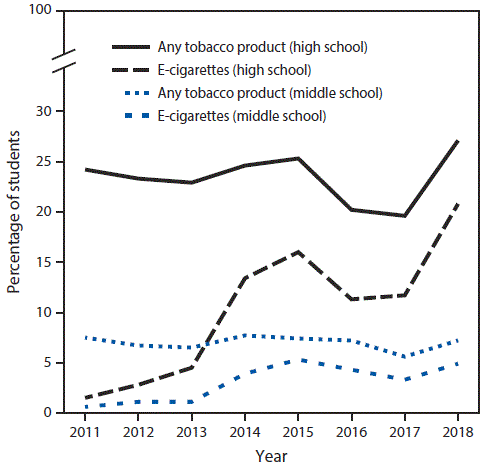| MMWR Weekly (No. 45 ) PDF of this issue |
Notes from the Field: Use of Electronic Cigarettes and Any Tobacco Product Among Middle and High School Students — United States, 2011–2018
Weekly / November 16, 2018 / 67(45);1276–1277
Karen A. Cullen, PhD1; Bridget K. Ambrose, PhD1; Andrea S. Gentzke, PhD2; Benjamin J. Apelberg, PhD1; Ahmed Jamal, MBBS2; Brian A. King, PhD2 (View author affiliations)
View suggested citation
Electronic cigarettes (e-cigarettes) are battery-powered devices that provide nicotine and other additives to the user in the form of an aerosol (1). E-cigarettes entered the U.S. marketplace in 2007 (1), and by 2014, e-cigarettes were the most commonly used tobacco product among U.S. youths (2). Data from the 2011–2018 National Youth Tobacco Survey (NYTS), a cross-sectional, voluntary, school-based, self-administered, pencil-and-paper survey of U.S. middle and high school students, were analyzed to determine the prevalence of current use (≥1 day in past 30 days) of e-cigarettes,* current use of any tobacco product,† frequency of (number of days during the preceding 30 days) e-cigarette use, and current use (any time during preceding 30 days) of any flavored e-cigarettes among U.S. middle school (grades 6–8) and high school (grades 9–12) students. Logistic regression (2011–2018) and t-tests (2017–2018) were performed to determine statistically significant differences (p<0.05).
Among high school students, current e-cigarette use increased from 1.5% (220,000 students) in 2011 to 20.8% (3.05 million students) in 2018 (p<0.001) (Figure). During 2017–2018, current e-cigarette use increased by 78% (from 11.7% to 20.8%, p<0.001). The proportion of current e-cigarette users who reported use on ≥20 of the past 30 days increased from 20.0% in 2017 to 27.7% in 2018 (p = 0.008). Among high school students, during 2017–2018, current use of any flavored e-cigarettes increased among current e-cigarette users (from 60.9% to 67.8%, p = 0.02); current use of menthol- or mint-flavored e-cigarettes increased among all current e-cigarette users (from 42.3% to 51.2%, p = 0.04) and current exclusive e-cigarette users (from 21.4% to 38.1%, p = 0.002).
Among middle school students, current e-cigarette use increased from 0.6% in 2011 (60,000 students) to 4.9% (570,000 students) in 2018 (p<0.001) (Figure). During 2017–2018, current e-cigarette use increased by 48% (from 3.3% to 4.9%, p = 0.001); the proportion of current e-cigarette users who reported use on ≥20 days of the past 30 days did not significantly change (from 12.9% to 16.2%, p = 0.26).
Current use of any tobacco product among high school students was 24.2% (3.69 million students) in 2011 and 27.1% (4.04 million students) in 2018 (p>0.05) (Figure). Current use of any tobacco product among middle school students was 7.5% (870,000 students) in 2011 and 7.2% (840,000 students) in 2018 (p>0.05). During 2017–2018, overall tobacco product use increased by 38% among high school students (from 19.6% to 27.1%, p<0.001) and by 29% among middle school students (from 5.6% to 7.2%, p = 0.008).
Current e-cigarette use increased considerably among U.S. middle and high school students during 2017–2018, reversing a decline observed in recent years and increasing overall tobacco product use (3). Moreover, during 2017–2018, frequent e-cigarette use increased among high school students. Although e-cigarettes have the potential to benefit adult smokers if used as a complete substitute for combustible tobacco smoking, the use of any form of tobacco product among youths, including e-cigarettes, is unsafe (1). The Surgeon General has concluded that e-cigarette use among youths and young adults is of public health concern; exposure to nicotine during adolescence can cause addiction and can harm the developing adolescent brain (1).
The rise in e-cigarette use during 2017–2018 is likely because of the recent popularity of e-cigarettes shaped like a USB flash drive, such as JUUL; these products can be used discreetly, have a high nicotine content, and come in flavors that appeal to youths (4). In September 2018, the Food and Drug Administration (FDA) issued more than 1,300 warning letters and civil money penalty fines to retailers who illegally sold e-cigarette products to minors, the majority of which were blu, JUUL, Logic, MarkTen XL, and Vuse; this was the largest coordinated enforcement effort in FDA’s history (5). Sustained implementation of proven population-based strategies, in coordination with the regulation of tobacco products by FDA, is key to reducing all forms of tobacco product use and initiation, including e-cigarettes, among U.S. youths (1).
Corresponding author: Karen A. Cullen, karen.cullen@fda.hhs.gov, 240-402-4513.
All authors have completed and submitted the ICMJE form for disclosure of potential conflicts of interest. No potential conflicts of interest were disclosed.
* Current e-cigarette use was defined as a response greater than “0 days” to the question, “During the past 30 days, on how many days did you use e-cigarettes?” The e-cigarette questions were preceded by the following information: “The next 11 questions are about electronic cigarettes or e-cigarettes. E-cigarettes are battery powered devices that usually contain a nicotine-based liquid that is vaporized and inhaled. You may know them as e-cigs, vape-pens, hookah-pens, e-hookahs, e-cigars, e-pipes, personal vaporizers, or mods. Some brand examples include NJOY, blu, Vuse, MarkTen, Logic, Vapin Plus, eGo, and Halo.”
† Any tobacco product use was defined as use of one or more of the following tobacco products on ≥1 day in the past 30 days: cigarettes, cigars (defined as cigars, cigarillos, or little cigars), smokeless tobacco (defined as chewing tobacco, snuff, or dip), e-cigarettes, hookahs, tobacco pipes, snus, dissolvable tobacco, and bidis.
References
- US Department of Health and Human Services. E-cigarette use among youth and young adults: a report of the Surgeon General. Atlanta, GA: US Department of Health and Human Services, CDC, National Center for Chronic Disease Prevention and Health Promotion, Office on Smoking and Health; 2016. https://e-cigarettes.surgeongeneral.gov/documents/2016_SGR_Full_Report_non-508.pdf
- Arrazola RA, Singh T, Corey CG, et al. Tobacco use among middle and high school students—United States, 2011–2014. MMWR Morb Mortal Wkly Rep 2015;64:381–5. PubMed
- Wang TW, Gentzke A, Sharapova S, Cullen KA, Ambrose BK, Jamal A. Tobacco product use among middle and high school students—United States, 2011–2017. MMWR Morb Mortal Wkly Rep 2018;67:629–33. CrossRef PubMed
- King BA, Gammon DG, Marynak KL, Rogers T. Electronic cigarettes sales in the United States, 2013–2017. JAMA 2018;320:1379–80. CrossRef PubMed
- Food and Drug Administration. FDA takes new steps to address epidemic of youth e-cigarette use, including a historic action against more than 1,300 retailers and 5 major manufacturers for their roles perpetuating youth access [press release]. Silver Spring, Maryland: US Department of Health and Human Services, Food and Drug Administration; 2018. https://www.fda.gov/NewsEvents/Newsroom/PressAnnouncements/ucm620184.htm
 FIGURE. Percentage of middle and high school students who currently use e-cigarettes* and any tobacco product† — National Youth Tobacco Survey, United States, 2011–2018
FIGURE. Percentage of middle and high school students who currently use e-cigarettes* and any tobacco product† — National Youth Tobacco Survey, United States, 2011–2018

* Current e-cigarette use was assessed by responses to these questions during the indicated survey years: “In the past 30 days, which of the following products have you used on at least one day?” and the response option, “Electronic cigarettes or e-cigarettes such as Ruyan or NJOY” (2011–2013); “During the past 30 days, on how many days did you use e-cigarettes such as Blu, 21st Century Smoke, or NJOY?” (2014); “During the past 30 days, on how many days did you use electronic cigarettes or e-cigarettes?” (2015); and “During the past 30 days, on how many days did you use e-cigarettes?” (2016–2018). During 2015–2018, e-cigarette questions were preceded by an introductory paragraph defining the product.
† Any tobacco product was defined as use of one or more of the following tobacco products on ≥1 day in the past 30 days: cigarettes, cigars (defined as cigars, cigarillos, or little cigars), smokeless tobacco (defined as chewing tobacco, snuff, or dip), e-cigarettes, hookahs, tobacco pipes, snus, dissolvable tobacco, and bidis.























.png)











No hay comentarios:
Publicar un comentario